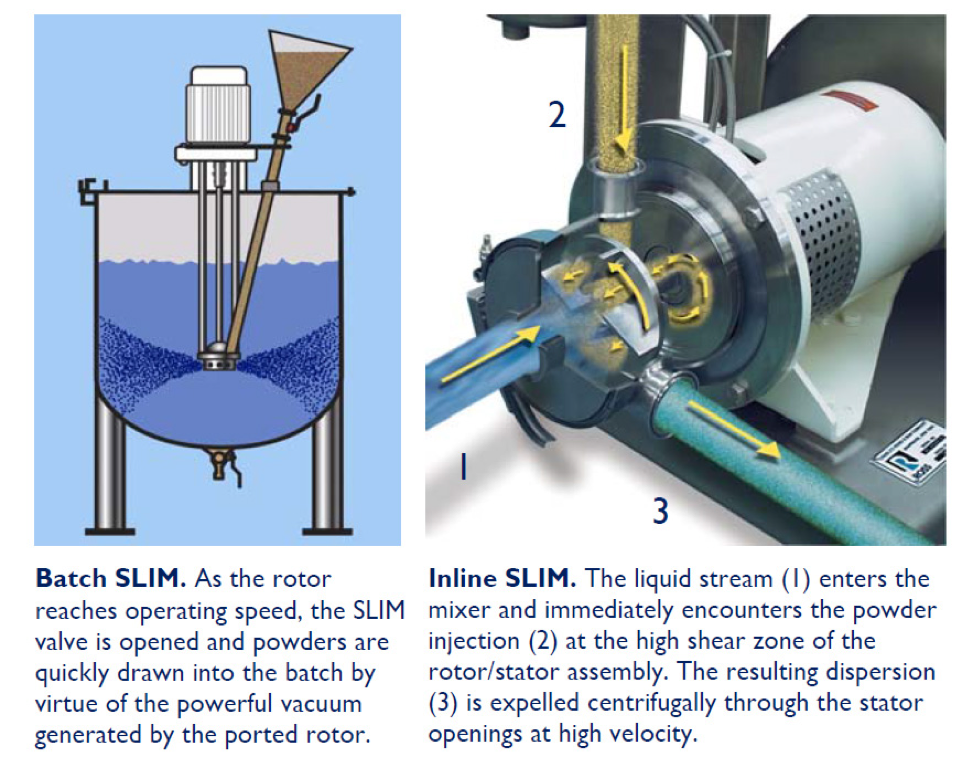This article showcases a few examples of specialty mixing equipment used in cosmetics and personal care manufacturing. Proper mixing is critical in the production of stable quality emulsions. By investing in a high-throughput mixing strategy that handles a wide range of viscosities and shear requirements, cosmetic manufacturers can gain increased flexibility to respond to ever-changing consumer tastes and market trends.
Sunscreen and Sun Tan Lotions

Mixing is a critical step in the production of sunscreen, largely because proper dispersion of the active ingredients and additives directly impacts the end product’s efficacy and stability. High Shear Mixers are utilized for dispersing active ingredients like titanium dioxide and zinc oxide, hydrating gums and thickeners, reducing the median droplet size of the base emulsion and dissolving additives.
The basic single-stage High Shear Mixer features a four-blade rotor turning at tip speeds around 3,000-4,000 ft/min within a close tolerance fixed stator. It imparts mechanical and hydraulic shear by continuously drawing product into the rotor and expelling it radially at high velocity through the openings in the stator. Built-in powder induction mechanisms like the Solids/Liquid Injection Manifold (SLIM) Technology extend the High Shear Mixer’s functionality by enabling more convenient raw material additions, faster dissolution/dispersion and more efficient hydration of thickeners.
Cosmetic Powders and Scented Powders
Thorough mixing in a well-designed Ribbon Blender is an effective method for preparing face powders, eye shadows, pressed make-up, foundations, blushes, bronzers and other cosmetics supplied in powder form. Blending fragrance into powders is also common operation in the manufacture of cosmetics, personal care and home products

Ribbon Blenders equipped with horizontal double helical ribbons are well proven in the manufacture of cosmetic powders. Pre-weighed dry raw materials such as talc, mica, silica, stearates, clay, rice starch, zinc oxide, iron oxides, titanium dioxide and various other pigments are loaded into a U-shaped trough. A full load usually corresponds to a product level around the tip of the outer ribbon allowing enough headroom for the materials to be vigorously blended. Any wet ingredients including the liquid binder and perfumes are gradually added to the blend through atomizing spray nozzles. This step is performed as the powders are being agitated to promote uniform coating and prevent the formation of undesired lumps.
Toothpaste

Toothpaste manufacturers rely on a range of mixers to accomplish various processing objectives including powder wet-out and dispersion, hydration of gums and polymers, homogenization of two or more liquids with different viscosities, and deaeration (vacuum mixing). High Speed Dispersers are utilized in the preparation of intermediate slurries and solutions. The saw-tooth blade in a High Speed Disperser generates a vortex into which solids can be added for quick incorporation into the batch. Acceptable flow patterns and turnover rates are easily achieved in dispersions up to around 50,000 cP in viscosity.
In addition, the finished toothpaste product is frequently batched in Multi-Shaft Mixers or Double Planetary Mixers due to their high viscosity (70,000 – 100,000 cP). Multi-Shaft Mixers are equipped with two or more independently-driven agitators working in tandem to deliver a combination of high shear agitation and laminar bulk flow.
Body Washes and Shower Gels
Powder dispersion is an important step in the production of body washes, shower gels, hand soaps, shampoos, lotions, aftershaves and other personal care products. Traditionally used turbine mixers and paddle agitators unfortunately often suffer from inefficiencies related to slow wet-out and incomplete dissolution. Once challenging powders form agglomerates or “fish eyes,” it is very difficult and time consuming to break them apart. Manufacturers resort to filtering out these lumps or devoting separate mixing tanks for certain powders. These solutions however negatively impact production costs and maintenance requirements.
A better processing method is achieved by systems like the Ross Solids/Liquid Injection Manifold (SLIM), a new generation rotor/stator mixer designed for rapid addition of powders without subsequent lumping. This technology combines solids and liquids at precisely the point where intense mixing takes place such that agglomerates are prevented from forming in the first place.
Paid content provided by Charles Ross and Son Company.
The views, opinions and technical analyses presented here are those of the author or advertiser, and are not necessarily those of ULProspector.com or UL Solutions. The appearance of this content in the UL Prospector Knowledge Center does not constitute an endorsement by UL Solutions or its affiliates.
All content is subject to copyright and may not be reproduced without prior authorization from UL Solutions or the content author.
The content has been made available for informational and educational purposes only. While the editors of this site may verify the accuracy of its content from time to time, we assume no responsibility for errors made by the author, editorial staff or any other contributor.
UL Solutions does not make any representations or warranties with respect to the accuracy, applicability, fitness or completeness of the content. UL Solutions does not warrant the performance, effectiveness or applicability of sites listed or linked to in any content.



Do you have low speed mixturers that wouldn’t generate much foam for anionic surfactant based products.